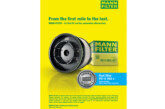As an OE manufacturer and system supplier, HELLA uses its expertise and experience to provide its five-step guide to preventative maintenance.
Checking the performance, functionality and operation of service items on a regular basis will help to extend their life, providing additional cost benefits.
The following guide highlights five key areas that will help to prevent problems and provides step-by-step instructions to reduce the potential risk of expensive vehicle downtime.
Batteries
Still the number one cause of vehicle breakdown across Europe, the battery is required not only to get the engine started, but is used in stabilising, filtering and providing the power needed for the vehicle’s ignition system. Therefore, checking the condition of the battery is a necessity. Firstly, check that the battery is of the correct specification for the application. Then check its voltage and charge if required.
Following this, the battery terminals/connections will need to be examined for any damage and that they are securely fastened. It is also important to check the battery casings for any potential signs of leakage and that it is correctly positioned and firmly clamped in the battery housing. Finally, if required, the battery should then be topped up to the maximum safe level with distilled water.
Starter Motors
Starter motors are put under enormous strain, particularly when the engine is first started and in sub-zero conditions. It is therefore very important to ensure it is correctly positioned and securely mounted in its housing. The next step is to look at the terminal connections as these must also be securely fastened and show no signs of wear or heat damage.
Alternators
The alternator is vital to ensure the battery remains well charged and to provide power for the engine’s electrical system. To make sure that it is maintained and functioning as it should, check it is firmly secured and adjusted correctly, as well as the condition and tension of the auxiliary belt that drives it.
Wiper Blades
In order to ensure that the wiper blades are working correctly, it is also important to check wiper arm linkages, as the whole system needs to work in unison. In light rain for example, worn blades can result in increased resistance and drag across the windscreen, putting excess strain on the arms and linkages. Likewise, damaged linkages can cause blades to wear unevenly or more quickly. So naturally, both elements should be replaced with any sign of wear or reduction in wiper performance.
Lighting
Begin by checking for correct positioning, performance, security and functionality of the lights and naturally replace any failed bulbs in the process. Examine the headlights – main and dipped beam – direction indicators, daytime running lights (if fitted), side markers and rear combination lights and markers. If there are any visible signs of damaged or cracked lenses then it is necessary to replace that specific unit.










